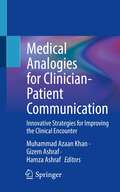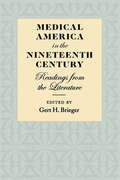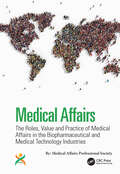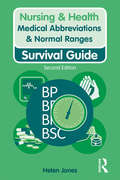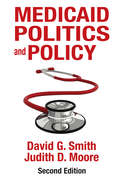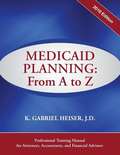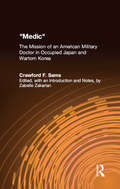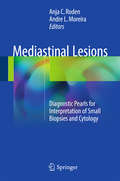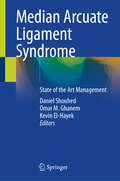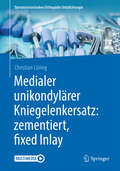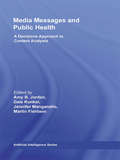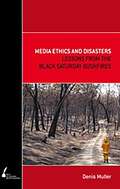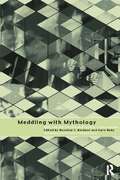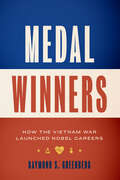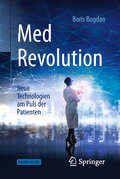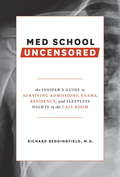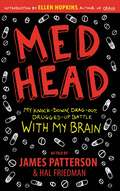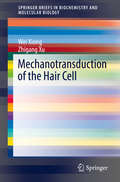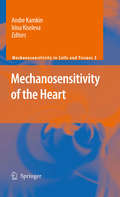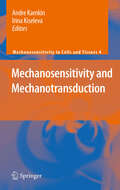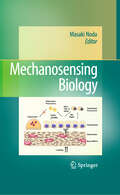- Table View
- List View
Medical Analogies for Clinician-Patient Communication: Innovative Strategies for Improving the Clinical Encounter
by Muhammad Azaan Khan Gizem Ashraf Hamza AshrafPatient-healthcare worker communication is the cornerstone of an informed and patient-centered approach to healthcare. It is continually stressed throughout all aspects of medical training and practice, but this can be impaired by the myriad of medical jargon and complex pathophysiology required in explaining a patient’s condition. This book aims to provide a comprehensive reference of analogies which simplify and make the most common medical conditions that patients may question about or be afflicted with comprehensible. There is need for an efficient way to translate years of study and experiential learning from the doctor and healthcare professional to the patient. The book contains over 200 analogies that span across 19 chapters covering a wide variety of medicine specialties, including but not limited to cardiology, dermatology, endocrinology, gastroenterology, and more. Each chapter follows a consistent format: a condition is given, the analogy title for the condition is given, and then the analogy is explained in the body text. The authors took some of the most common encountered medical conditions and attributed them to digestible analogies that help bridge the gap between healthcare professional to patient. Medical Analogies for Clinician-Patient Communication: Innovative Strategies for Improving the Clinical Encounter serves as a fruitful reference for anyone wanting to communicate profoundly with their patients without forfeiting brevity.
Medical America in the Nineteenth Century: Readings from the Literature
by Gert H. BriegerStudents of the history of medicine and of American history in general will welcome this collection of thirty papers originally published in nineteenth-century medical journals and lay publications. Each highlights a specific problem or medical attitude of the period, and together they present an illuminating panorama of the medical profession and of public health in nineteenth-century America. Many of the problems faced by students, practitioners, and patients of the last century are surprisingly similar to those still being encountered today.Dr. Brieger has selected papers that illustrate the issues and developments in medical education, medical practice, surgery, hospitals, hygiene, and psychiatry. They range from Benjamin Rush's "On the Cause of Death in Diseases That Are Not Incurable," to a paper by Robert F. Weir "On the Antiseptic Treatment of Wounds, and Its Results" and an article by Stephen Smith, "New York the Unclean." The final selection, the Announcement of The Johns Hopkins Medical School, stands as a landmark that foretells the beginning of a new era.
Medical Affairs: The Roles, Value and Practice of Medical Affairs in the Biopharmaceutical and Medical Technology Industries
by Kirk Shepard, Charlotte Kremer, Garth SundemMedical Affairs is one of the three strategic pillars of the pharmaceutical and MedTech industries, but while clear career paths exist for Commercial and Research and Development, there is no formal training structure for Medical Affairs professionals. Medical and scientific expertise is a prerequisite for entry into the function, and many people transitioning into Medical Affairs have advanced degrees such as PhD, MD, or PharmD. However, these clinical/scientific experts may not be especially well-versed in aspects of industry such as the drug development lifecycle, crossfunctional collaborations within industry, and digital tools that are transforming the ways Medical Affairs generates and disseminates knowledge. This primer for aspiring and early-career Medical Affairs professionals equips readers with the baseline skills and understanding to excel across roles.Features: Defines the purpose and value of Medical Affairs and provides clear career paths for scientific experts seeking their place within the pharmaceutical and MedTech industries. Provides guideance and baseline competencies for roles within Medical Affairs including Medical Communications, Evidence Generation, Field Medical, Compliance, and many others. Specifies the "true north" of the Medical Affairs profession as ensuring patients receive maximum benefit from industry innovations including drugs, diagnostics and devices. Presents the purpose and specific roles of Medical Affairs roles across organization types including biotechs, small/medium/large pharma and device/diagnostic companies, taking into account adjustments in the practic of Medical Affairs to meet the needs of developing fields such as rare disease and gene therapy. Leverages the expertise of over 60 Medical Affairs leaders across companies, representing the first unified, global understanding of the Medical Affairs profession.
Medical Accident Liability and Redress in English and French Law
by Simon TaylorIn 2002 France introduced an out-of-court settlement scheme for medical accidents. The scheme guarantees compensation for the victims of the most serious medical accidents irrespective of fault and operates in parallel with existing liability rules. In this book Simon Taylor compares English and French law on medical accident liability and redress and considers what lessons the French model can provide for potential reform in England and elsewhere. Taylor emphasizes the effect of the English and French rules on access to compensation and on the cost of liability and examines the problems that have been posed by the introduction of an administrative redress scheme in France. This book looks at the potential consequences of English and French rules for the doctor-patient relationship and for patient safety, and considers the role that national legal traditions and cultures of civil liability in England and France play in shaping national law in this area.
Medical Abbreviations & Normal Ranges: Survival Guide (Nursing and Health Survival Guides)
by Helen JonesPart of the skill of nursing and healthcare involves being able to decipher and understand the meanings of results and abbreviations. Fully updated, this second edition is a handy survival guide which will supply you with up-to-date information and help you understand this language, so that you can provide appropriate holistic care to your patients.
Medicaid Politics and Policy
by David G. SmithThe story of Medicaid comes alive for readers in this strong narrative, including detailed accounts of important policy changes and extensive use of interviews. A central theme of the book is that Medicaid is a "weak entitlement," one less established or effectively defended than Medicare or Social Security, but more secure than welfare or food stamps.In their analysis, the authors argue that the future of Medicaid is sound. It has the flexibility to be adapted by states as well as to allow for policy innovation. At the same time, the program lacks an effective mechanism for overall reform. They note Medicaid has become a source of perennial political controversy as it has grown to become the largest health insurance system in the country.The book's dual emphasis on politics and policy is important in making the arcane Medicaid program accessible to readersand in distinguishing policy grounded in analysis from partisan ideology. This second edition features a new preface, three new chapters accounting for the changes to the Affordable Care Act, and an updated glossary.
Medicaid Planning: From A to Z (2018 Ed. )
by K. Gabriel HeiserIf you wish to advise clients how to qualify for nursing home Medicaid while protecting their assets, this is the definitive book! Written by an elder law attorney with over 25 years of experience, this manual is the professional edition version of attorney Heiser's best-selling Medicaid Secrets book. This manual is geared toward attorneys, accountants, and financial advisors seeking up-to-date and accessible information on the Medicaid program rules as well as a complete analysis of available Medicaid asset protection techniques for their clients. Includes a summary of all income and asset rules for both married and single individuals, together with numerous examples and several case studies, which take the planner through the same thought processes that an experienced elder law attorney would go through when analyzing a real-life client's situation. The book includes tips on: how to title the home so the client does not lose it to the state; how to make transfers to family members that won't disqualify the client from Medicaid; how "Medicaid annuities" work to make assets "disappear" for Medicaid eligibility purposes; clever ideas for "spending down" assets; what to change in a client's will to save thousands of dollars if the spouse ever needs nursing home care; avoiding the state's reimbursement claim following the nursing home resident's death; and much more. The 2018 Edition has been expanded, revised, and completely updated to incorporate all changes in the law as of January 1, 2018, and includes two chapters on Veterans' benefits as well as a 39-page Ethics of Elder Law section. Completely annotated with all case citations and statutory references given in over 560 footnotes. Also includes full copies of relevant statutes and a sample filled-out Medicaid application, plus sample clauses for deeds, wills, powers of attorney, etc.
Medic: The Mission of an American Military Doctor in Occupied Japan and Wartorn Korea
by Crawford F. Sams Zabelle ZakarianIn the aftermath of the bombing of Hiroshima and Nagasaki, Crawford F. Sams led the most unprecedented and unsurpassed reforms in public health history, as chief of the Public Health and Welfare Section of the Supreme Commander of Allied Powers in East Asia. "Medic" is Sams's firsthand account of public health reforms in Japan during the occupation and their significance for the formation of a stable and democratic state in Asia after World War II. "Medic" also tells of the strenuous efforts to control disease among refugees and civilians during the Korean War, which had enormously high civilian casualties. Sams recounts the humanitarian, military, and ideological reasons for controlling disease during military operations in Korea, where he served, first, as a health and welfare adviser to the U.S. Military Command that occupied Korea south of the 38th parallel and, later, as the chief of Health and Welfare of the United Nations Command. In presenting a larger picture of the effects of disease on the course of military operations and in the aftermath of catastrophic bombings and depravation, Crawford Sams has left a written document that reveals the convictions and ideals that guided his generation of military leaders.
Mediating Alzheimer's: Cognition and Personhood
by Scott SelbergAn exploration of the representational culture of Alzheimer&’s disease and how media technologies shape our ideas of cognition and aging With no known cause or cure despite a century of research, Alzheimer&’s disease is a true medical mystery. In Mediating Alzheimer&’s, Scott Selberg examines the nature of this enduring national health crisis by looking at the disease&’s relationship to media and representation. He shows how collective investments in different kinds of media have historically shaped how we understand, treat, and live with this disease. Selberg demonstrates how the cognitive abilities that Alzheimer&’s threatens—memory, for example—are integrated into the operations of representational technologies, from Polaroid photographs to Post-its to digital artificial intelligence. Focusing on a wide variety of media technologies, such as neuroimaging, art therapy, virtual reality, and social media, he shows how these cognitively oriented media ultimately help define personhood for people with Alzheimer&’s. Media have changed the practices of successful aging in the United States, and Selberg takes us deep into how technologies like digital brain-training and online care networks shape ideas of cognition and healthy aging.Packed with startlingly fresh insights, Mediating Alzheimer&’s contributes to debates around bioethics, the labor of caregiving, and a national economy increasingly invested in communication and digital media. Probing the very technologies that promise to save and understand our brains, it gives us new ways of understanding Alzheimer&’s disease and aging in America.
Mediastinal Lesions
by Anja C. Roden Andre L. MoreiraThis book addresses the current concepts in tissue acquisition, diagnosis, and classification of mediastinal lesions in small biopsies including cytology. Examples of mediastinal diseases that are either more common, more challenging to diagnose, or have a differential diagnosis that is important and might require different modes of treatment are highlighted. The knowledge of some key morphologic features and immunohistochemical pitfalls will be helpful for the practicing pathologist to tackle this challenge. The general workup of a mediastinal biopsy and the workup of major disease groups in mediastinal pathology which the general pathologist should be familiar with is discussed. Morphologic and, if applicable, immunophenotypic and molecular features that can help to distinguish these disease entities are highlighted. Furthermore, the reader will learn about the pertinent clinical implications of the diseases. Mediastinal Lesions: Diagnostic Pearls for Interpretation of Small Biopsies and Cytology will be a reference guide for pathologists, pathologists-in-training, and allied professionals, including oncologists, pulmonologists, surgeons, and radiologists.
Median Arcuate Ligament Syndrome: State of the Art Management
by Omar M. Ghanem Daniel Shouhed Kevin El-HayekMedian Arcuate Ligament Syndrome (MALS) is a rare and poorly understood disease that affects many individuals worldwide. Patients with MALS present with debilitating epigastric abdominal pain, a fear of eating (sitophobia), nausea, vomiting and a poor quality of life. Patients are typically younger, with the vast majority of patients being female (80-90%). Patients may present with significant weight loss after a prolonged time to establish the diagnosis. This unique text provides a comprehensive review of MALS and is a valuable resource for physicians and researchers hoping to better understand and manage MALS. It sheds new light on recent advancements, including the neurogenic nature of this syndrome, adoption of minimally invasive surgery for treatment, and the associated conditions that make treating the patient so challenging. Another area this book explores is the value of neurolysis alone versus celiac ganglion resection. The book reviews new data about the different surgical approaches to MALS in relation to nerve resection as well as laparoscopic and robotic approaches to surgery, highlighting the complex diagnostic work-up that is needed to accurately diagnose MALS and, more importantly, to rule out more common conditions that may mimic MALS.
Medialer unikondylärer Kniegelenkersatz: zementiert, fixed Inlay (Operationstechniken Orthopädie Unfallchirurgie)
by Christian LüringDas Buch: beschreibt die Implantation eines medialen, zementierten Teilgelenkersatzes am Kniegelenk am Beispiel des DePuySynthes SIGMA® Partial Knees mit einem fixen Inlay. Der Schwerpunkt liegt dabei auf der Praxis: die Operation wird Schritt für Schritt beschrieben. Dabei wird besonderes Augenmerk auf die Fallstricke während der Operation gelegt. Neben den zahlreichen brillanten Grafiken und Fotos, die die Operation visualisieren, wird der Operationsverlauf in einem Video demonstriert. So ist die Umsetzung der Theorie in die Praxis auf kurzem Weg möglich.Das Video: einfach die Springer Multimedia App kostenfrei herunterladen, das Standbild im letzten Kapitel des Buches scannen und das Video streamen.
Media Messages and Public Health: A Decisions Approach to Content Analysis
by Martin Fishbein Amy B. Jordan Dale Kunkel Jennifer ManganelloMedia Messages and Public Health addresses the full range of methodological and conceptual issues involved in content analysis research, specifically focused on public health-related messages and behaviors. Uniquely tailored to the challenges faced by content researchers interested in the study of public health topics, coverage includes: Conceptual and methodological foundations involved in the practice of content analysis research used to examine public health issues. Measurement challenges posed by the broad range of media. Use of content analysis across multiple media types. The potential for individual differences in audience interpretation of message content. Case studies that examine public health issues in the media to illustration the decisions that are made when developing content analysis studies. The volume concludes with a set of guidelines for optimal content analysis research, and suggests ways in which the field can accommodate new technologies and new ways of using media. Developed for researchers in communication, media, and public health, this unique resource demonstrates how the variety of decisions researchers make along the way allows the exploration of traditions, assumptions and implications for each varying alternative and ultimately advances the science of content analysis research.
Media Ethics and Disasters: Lessons from the Black Saturday Bushfires
by Denis MullerJournalists do not often get the chance to reflect on the ethical side of their work, and the public they serve knows little about it. What the public sees is often negative: intrusive cameras, shouted questions, rude and aggressive behaviour. But journalists tend to go from one story to the next with little time to think deeply about the impact their work has on the people they cover, or how their professional practices might be refined. Written in collaboration with the Centre for Advanced Journalism at the University of Melbourne, Media Ethics and Disasters: Lessons from the Black Saturday Bushfires gives journalists the chance to reflect on the ethical issues that arose during coverage of the Black Saturday bushfires in Victoria in February 2009, and by doing so to contribute to their professional education. It presents; mostly in their own words; what journalists said about how they responded to the many dilemmas that confronted them and provides insight into the reasons for their actions. For the public this is new territory. The book illustrates the range of ethical problems that journalists confronted at the fire ground. There were good decisions and bad decisions, and the 28 journalists interviewed for the book were remarkably frank about both. There are lessons too for the emergency services. The way they and the media interacted created many difficulties, and the research here shows there is still much to learn about management of the media at disaster scenes.
MediQuik Drug Cards
by Lww Carla VitalePublisher’s Note: Products purchased from 3rd Party sellers are not guaranteed by the Publisher for quality, authenticity, or access to any online entitlements included with the product. Fully updated cards cover 300+ of the most commonly prescribed drugs. Each card provides concise drug information to be used by nursing students during clinical rotations, for NCLEX prep and by practicing nurses who need a quick portable reference to the most common drugs. The cards offer important drug information including generic and trade names with pronunciations, indications and dosages, and contraindications and cautions. NEW, color has been added to cards, making it easier to find essential information including lifespan considerations, assessment, key nursing diagnosis, planning and implementation and evaluation Cards include, drug names, class, action, adverse reactions, nursing considerations, and patient dosing Each card includes a hole punch and a Ring and Pouch are included in the package to allow the user to carry only the cards needed
Meddling with Mythology: AIDS and the Social Construction of Knowledge
by Rosaline S. Barbour Guro HubyMeddling with Mythology examines the role of research in the construction of modern mythology or folklore surrounding HIV/AIDS. Researchers from a variety of disciplines reflect on the insights gained and the impact of their work, in light of the initial panic surrounding the prediction of an AIDS epidemic. Issues discussed include:- * power * representation * the politics of text * understanding research relationships * impact of research on researchers and responders * potential for change. Meddling with Mythology takes the reader from the theoretical to the practicable and from the public to the personal in the representations of AIDS. The issues raised here also have great significance for those concerned with the social construction of knowledge, theory building and the research process more generally.
Medal Winners: How the Vietnam War Launched Nobel Careers
by Raymond S. GreenbergAs the ground war in Vietnam escalated in the late 1960s, the US government leveraged the so-called doctor draft to secure adequate numbers of medical personnel in the armed forces. Among newly minted physicians’ few alternatives to military service was the Clinical Associate Training Program at the National Institutes of Health. Though only a small percentage of applicants were accepted, the elite program launched an unprecedented number of remarkable scientific careers that would revolutionize medicine at the end of the twentieth century. Medal Winners recounts this overlooked chapter and unforeseen byproduct of the Vietnam War through the lives of four former NIH clinical associates who would go on to become Nobel laureates. Raymond S. Greenberg traces their stories from their pre-NIH years and apprenticeships through their subsequent Nobel Prize–winning work, which transformed treatment of heart disease, cancer, and other diseases. Greenberg shows how the Vietnam draft unintentionally ushered in a golden era of research by bringing talented young physicians under the tutelage of leading scientists and offers a lesson in what it may take to replicate such a towering center of scientific innovation as the NIH in the 1960s and 1970s.
Medal Winners: How the Vietnam War Launched Nobel Careers
by Raymond S. GreenbergAs the ground war in Vietnam escalated in the late 1960s, the US government leveraged the so-called doctor draft to secure adequate numbers of medical personnel in the armed forces. Among newly minted physicians’ few alternatives to military service was the Clinical Associate Training Program at the National Institutes of Health. Though only a small percentage of applicants were accepted, the elite program launched an unprecedented number of remarkable scientific careers that would revolutionize medicine at the end of the twentieth century. Medal Winners recounts this overlooked chapter and unforeseen byproduct of the Vietnam War through the lives of four former NIH clinical associates who would go on to become Nobel laureates. Raymond S. Greenberg traces their stories from their pre-NIH years and apprenticeships through their subsequent Nobel Prize–winning work, which transformed treatment of heart disease, cancer, and other diseases. Greenberg shows how the Vietnam draft unintentionally ushered in a golden era of research by bringing talented young physicians under the tutelage of leading scientists and offers a lesson in what it may take to replicate such a towering center of scientific innovation as the NIH in the 1960s and 1970s.
MedRevolution: Neue Technologien am Puls der Patienten
by Boris BogdanIn naher Zukunft regiert der Roboter im OP, erscheint der Patient im Double als Hologramm, kommen Ersatzorgane aus dem Drucker, überwachen Gesundheits-Apps Gesunde wie Kranke, werden Nanokapseln als Medizin durch den Körper geschleust - was sich wie Fiction anhört, steht unmittelbar vor der Realisierung. Vieles davon ist bereits möglich, wartet auf den flächendeckenden Einsatz. Die Digitalisierung im Verbund mit einer Reihe weiterer neuer Technologien wird innerhalb weniger Jahre Medizin, Medizintechnik und Gesundheitswesen revolutionieren. Die Gesundheitsversorgung wie wir sie heute kennen, wird sich dadurch grundlegend neu erfinden: Der Fokus wird von der Behandlung von Symptomen auf die Prävention und Erhaltung der Gesundheit wandern. Daten werden eine nie dagewesene Transparenz bieten. Konsumenten werden mündiger und selbstständiger ihre Gesundheit steuern. Dieses Buch stellt die technologischen Kräfte, die zu dieser tektonischen Verschiebung führen und fester Bestandteil unserer Gesundheitsversorgung werden, einzeln vor: Cloud Computing, Internet of Things, künstliche Intelligenz, 3-D-Druck, Virtual Realilty, Nanomedizin. Es beleuchtet zugleich die gesellschaftlichen Herausforderungen und zeigt in einem Ausblick,was sich dadurch für Konsumenten und Patienten ändern wird.
Med School Uncensored: The Insider's Guide to Surviving Admissions, Exams, Residency, and Sleepless Nights in the Call Room
by Richard BeddingfieldAn entertaining insider's guide to the good, the bad, and the ugly of med school--with everything pre-med and med students need to know, from day one, to maximize opportunities and avoid mistakes.Cardiothoracic anesthesiologist and recent med school grad Dr. Richard Beddingfield serves as an unofficial older brother for pre-med and incoming med students--dishing on all the stuff he would've wanted to know from the beginning in order to make the most of med school's opportunities, while staying sane through the gauntlets of applying to and succeeding at med school, residency, fellowship, and starting work as a new physician. With advice from additional recent Ivy League med school grads and top-tier hospital residents, this all-in-one guide is a must-have for everyone who dreams of becoming a doctor.
Med Head: My Knock-down, Drag-out, Drugged-up Battle with My Brain
by James Patterson Hal FriedmanCory Friedman woke up one morning when he was five years old with the uncontrollable urge to twitch his neck. From that day forward his life became a hell of irrepressible tics and involuntary utterances, and Cory embarked on an excruciating journey from specialist to specialist to discover the cause of his disease. Soon it became unclear what tics were symptoms of his disease and what were side effects of the countless combinations of drugs. The only certainty is that it kept getting worse. Simply put: Cory Friedman's life was a living hell. This is the true story of Cory and his family's decades-long battle for survival in the face of extraordinary difficulties and a maddening medical establishment. It is a heart-rending story of struggle and triumph with a climax as dramatic as any James Patterson thriller.
Mechanotransduction of the Hair Cell (Springerbriefs In Biochemistry And Molecular Biology Ser.)
by Wei Xiong Zhigang XuThis book summarizes the emerging experimental evidence on hair-cell mechanotransduction, and covers hair’s cellular structure, biophysical properties, molecular components and functions. Auditory hair cells convert sound-induced vibration into electrical signals. This biological process, mechanotransduction, is what allows us to hear and communicate in our daily lives. However, our grasp of hair-cell mechanotransduction is still far from complete. Recent advances in molecular genetics and biophysics have helped us gain deeper insights into this process, especially the molecular constituent and operation of the channel complex. This book provides a cutting-edge snapshot for all readers who are interested in or studying how auditory hair cells detect sound.
Mechanosensitivity of the Heart
by Irina Kiseleva Andre KamkinThis book presents the latest findings in field of research of mechanosensitivity of the heart. The Volume focuses on molecular mechanisms of mechanotransduction in cardiac cells. It contains a detailed description of several stretch-induced signaling cascades with multiple levels of crosstalk between different pathways. It highlights the role of cardiac stretch-activated channels and their contribution to cardiac performance. This book provides justification of scientific significance and potential for clinical applications of findings of fundamental investigations in the field of mechanosensitivity, which is stressed by description of reported increased sensitivity of cardiac cells to mechanical stress under various pathological conditions. It contains new insights into mechanoelectrical feedback on the level of the whole heart and results of experimental investigations of electromechanical properties of cardiac tissue. This book is a unique collection of reviews outlining current knowledge and future developments in this rapidly growing field. Currently, investigations of the effects of mechanical stress on the heart are focused on several issues. The majority of studies investigate the effects of mechanical stimulation on mechanosensitive channels, as its primary target and interactive agent, and aim on description of downstream intracellular signaling pathways together with addressing general issues of biomechanics of the heart. Knowledge of biomechanics, and mechanisms which underlie it on molecular, cellular, tissue, organ and organism, is necessary for understanding of the normal functioning of living organisms and allows to predict changes, which arise due to alterations of their environment, and possibly will allow to develop new methods of artificial intervention. The book brings up the problem closer to the experts in related medical and biological sciences as well as practicing doctors besides just presenting the latest achievements in the field.
Mechanosensitivity and Mechanotransduction
by Irina Kiseleva Andre KamkinThis book presents the latest findings in the field of research of mechanosensitivity and mechanotransduction in different cells and tissues. Mechanosensitivity and mechanotransduction of the heart and vascular cells, in the lung, in bone and joint tissues, in sensor systems and in blood cells are described in detail. This Volume focuses on molecular mechanisms of mechanosensitivity and mechanotransduction via cytoskeleton. Integrin-mediated mechanotransduction, the role of actin cytoskeleton and the role of other cytoskeletal elements are discussed. It contains a detailed description of several stretch-induced signaling cascades with multiple levels of crosstalk between different pathways. It contains a description of the role of nitric oxide in regulation of cardiac activity and in regulation of mechanically gated channels in the heart. In the heart mechanical signals are propagated into the intracellular space primarily via integrin-linked complexes, and are subsequently transmitted from cell to cell via paracrine signaling. Biochemical signals derived from mechanical stimuli activate both acute phosphorylation of signaling cascades, such as in the PI3K, FAK, and ILK pathways, and long-term morphological modii cations via intracellular cytoskeletal reorganization and extracellular matrix remodelling. Cellular and molecular effects of mechanical stretch on vascular cells are also discussed. This Volume highlights the role of mechanotransduction in the lung, in bone and joint tissues. For the first time mechanosensitivity and mechanotransduction in blood cells are discussed. It contains new insights into mechanosensitive K+ channels functioning in mouse B lymphocytes. This book is a unique collection of reviews outlining current knowledge and future developments in this rapidly growing field. Currently, investigations of the molecular mechanisms of mechanosensitivity and mechanotransduction are focused on several issues. The majority of studies investigate intracellular signaling pathways. Knowledge of the mechanisms which underlie these processes is necessary for understanding of the normal functioning of different organs and tissues and allows to predict changes, which arise due to alterations of their environment. Possibly such knowledge will allow the development of new methods of artificial intervention and therapies. This book brings up the problem closer to the experts in related medical and biological sciences as well as practicing doctors besides just presenting the latest achievements in the field.
Mechanosensing Biology
by Masaki NodaMechanical stress is vital to the functioning of the body, especially for tissues such as bone, muscle, heart, and vessels. It is well known that astronauts and bedridden patients suffer muscle and bone loss from lack of use. Even the heart, in pumping blood, causes mechanical stress to itself and to vascular tissue. With the loss of mechanical stress, homeostasis becomes impaired and leads to pathological conditions such as osteopenia, muscle atrophy, and vascular tissue dysfunction. In elderly populations, such mechanical pathophysiology, as well as the mechanical activities of locomotor and cardiovascular systems, is important because skeletal and heart functions decline and cause diseases in other organs. In this monograph, mechanical stress is discussed by experts in the field with respect to molecular, cellular, and tissue aspects in relation to medicine. Covering topics such as gravity and tissues and disuse osteoporosis, the book provides the most up-to-date information on cutting-edge advancements in the field of mechanobiology and is a timely contribution to research into locomotor and circulatory diseases that are major problems in contemporary society.
